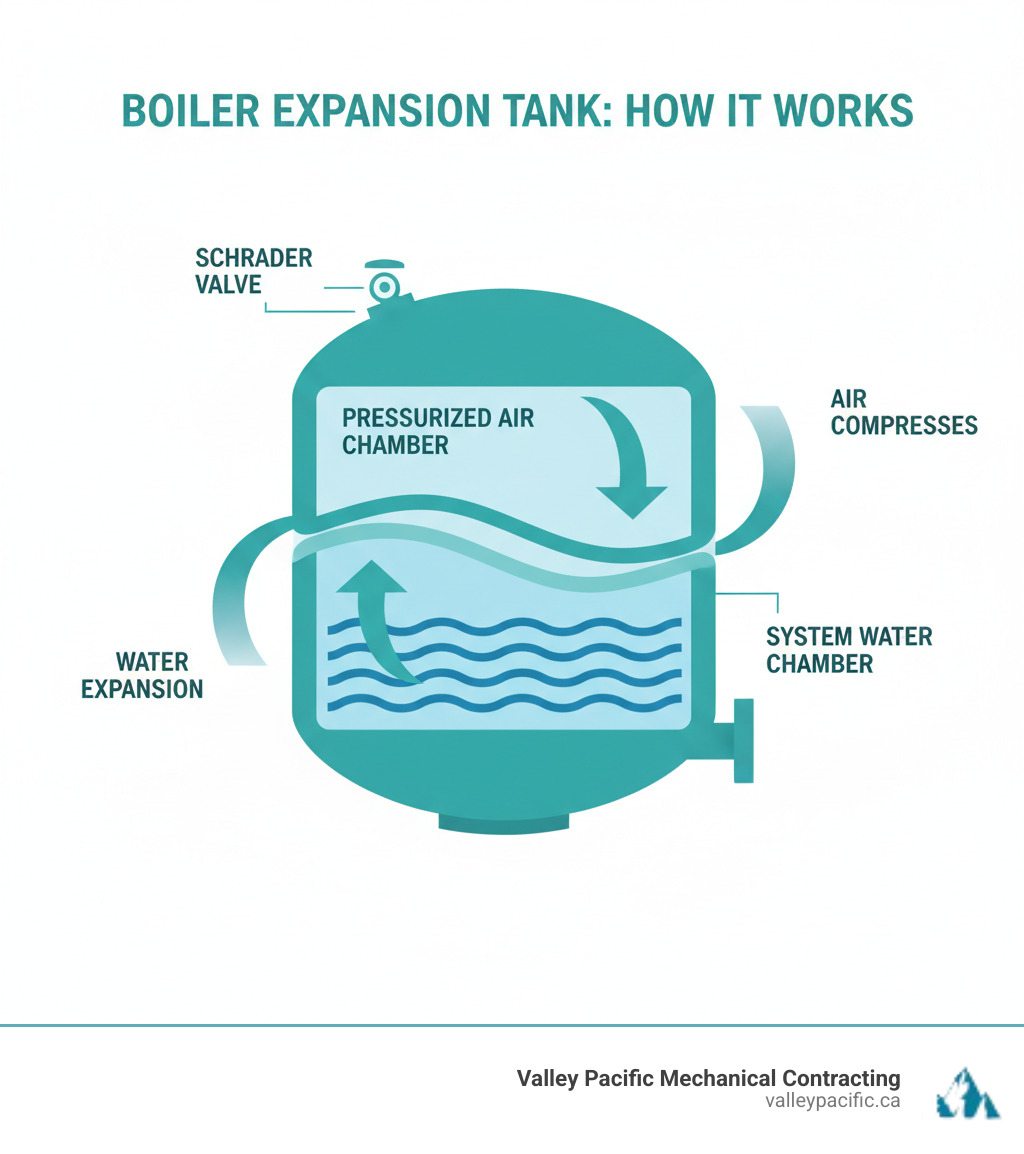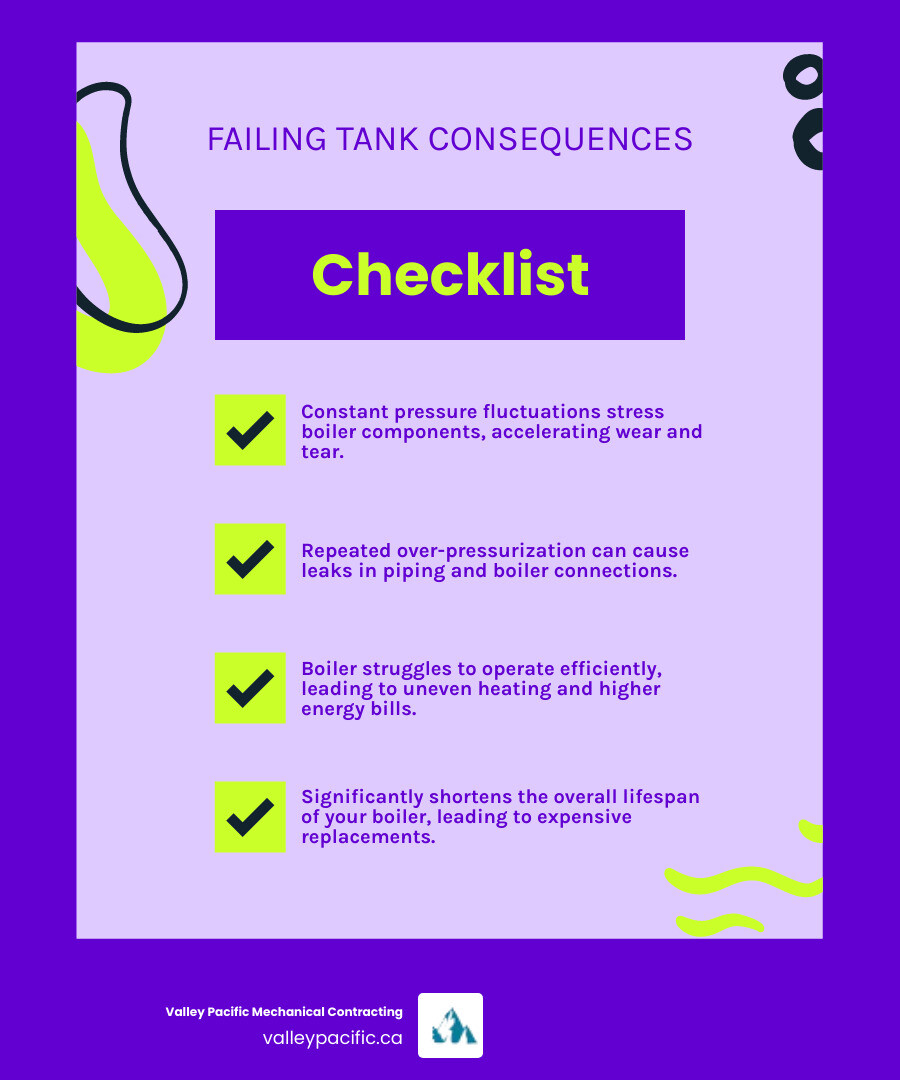Expand Your Knowledge: Selecting the Perfect Boiler Expansion Tank


Why Your Boiler System Depends on This Critical Component
A Boiler expansion tank is a safety device that manages water expansion in closed-loop heating systems. As water heats, it expands by 4-9%. Without a tank to absorb this extra volume, pressure would spike dangerously, damaging your boiler and pipes. The tank contains two chambers separated by a flexible diaphragm: one for pressurized air and the other for system water. When water expands, it pushes against the diaphragm, compressing the air to safely absorb the pressure.
Quick Answer for Choosing the Right Expansion Tank:
- Combi boilers typically have internal expansion vessels.
- System and regular boilers usually need external tanks.
- Sizing matters: The tank should be roughly 1/4 of your boiler's water volume.
- Standard pressure: Most residential tanks are pre-charged to 12-15 PSI.
- Typical lifespan: Expect 5-10 years before replacement is needed.
Most homeowners don't notice their expansion tank until something goes wrong. Signs of failure include a wildly swinging pressure gauge, water dripping from the pressure relief valve, or banging noises in your pipes. These indicate the tank may have failed or lost its air charge.
This component acts as a shock absorber, maintaining stable pressure as water heats and cools. Without it, your boiler would face dangerous over-pressurization with every heating cycle.

Simple guide to Boiler expansion tank terms:
Understanding the Boiler Expansion Tank: Function and Mechanics
In a closed heating system, water flows in a continuous loop from the boiler through your radiators and back again. A key principle at play is thermal expansion: when water heats up, its volume can increase by 4% to 9%. In a sealed system, this expansion creates immense pressure with nowhere to go.
This is where the boiler expansion tank becomes essential. It acts as a pressure cushion or shock absorber, preventing dangerous pressure spikes that would otherwise stress every pipe, valve, and connection in your home each time the boiler fires up.

What is its Primary Function?
The primary job of a boiler expansion tank is to absorb the excess water volume created during heating. Inside the tank, a flexible rubber diaphragm or bladder separates a chamber of pressurized air from the system's water. As the water heats and expands, it pushes against this membrane, compressing the air on the other side.
This action provides the necessary space for the expanded water, preventing pressure spikes. When the water cools and contracts, the compressed air pushes it back into the system, maintaining stable pressure. This automatic cycle protects your boiler components from the stress of constant pressure fluctuations. For more details on how these parts work, see What Is An Expansion Vessel?.
How it Differs from a Pressure Relief Valve (PRV)
While often confused, the expansion tank and the pressure relief valve (PRV) have distinct roles.
- The expansion tank is proactive. It works constantly during normal operation to manage the everyday pressure changes from thermal expansion.
- The pressure relief valve (PRV) is reactive. It's an emergency backup that only activates when pressure reaches a dangerous level (typically 30 PSI), discharging water to prevent catastrophic failure.
An important warning sign: if you see water dripping from your PRV, it often means your expansion tank has failed. The PRV is being forced to do the expansion tank's job, a sign of trouble that can lead to other issues, as discussed in our guide on Troubleshooting No Hot Water From Boiler. Your expansion tank ensures daily efficiency, while the PRV is your last line of defense.
Types, Sizing, and Location
The type, size, and location of your boiler expansion tank are all crucial for safe and smooth system operation. Understanding your boiler's specific requirements ensures you get the right fit from the start.

Diaphragm vs. Bladder Tanks
Modern boiler expansion tanks come in two main types, both using a flexible membrane to separate air and water.
Diaphragm tanks feature a fixed rubber diaphragm that divides the tank into an air chamber and a water chamber. System water touches the tank's steel shell, making these a reliable and cost-effective choice for most homes. However, this design makes proper air elimination important to prevent internal corrosion.
Bladder tanks use a replaceable rubber bladder that contains the system water, preventing it from ever touching the tank's metal walls. This isolation reduces the risk of corrosion and can extend the tank's lifespan, making it a popular choice for larger or commercial systems. They are also more compact than older tank styles.
While bladder tanks may offer greater longevity, a well-maintained diaphragm tank can serve a home effectively for years.
How to Properly Size Your Boiler Expansion Tank
Correctly sizing a boiler expansion tank is critical. A tank that's too small will cause the pressure relief valve to drip and lead to constant pressure issues. One that's too large is an unnecessary expense and takes up extra space.
Proper sizing depends on several factors:
- System water volume: The total amount of water in your boiler, pipes, and radiators.
- Boiler temperature range: Hotter systems cause more expansion and require a larger tank.
- Fill pressure: The system's cold pressure must match the tank's pre-charge pressure.
- Pressure relief valve setting: The tank must keep operating pressure below this emergency threshold.
Given these variables, professional calculation is the best way to ensure your tank is perfectly matched to your system. This is a key part of designing and maintaining a reliable Boiler Heating System.
Where to Find the Expansion Tank
The location of your boiler expansion tank depends on your boiler type.
Combi boilers typically have an internal expansion vessel built into the unit's casing for a compact, space-saving design.
System and regular boilers almost always use an external expansion tank. You'll find it mounted on a wall or hanging from a pipe near the boiler, connected to the supply-side piping. It is often located on the suction side of the circulator pump.
Whether your tank is internal or external, our technicians in Langley, Maple Ridge, and Mission know exactly where to find and service it.
Diagnosing and Addressing Expansion Tank Problems
Over time, the diaphragm inside a boiler expansion tank can weaken or rupture, causing the air cushion to escape and the tank to become "waterlogged." When this happens, it can no longer manage pressure, and your system will show signs of distress. Catching these problems early through regular Boiler System Maintenance can prevent more serious issues.
Common Signs of a Failing Expansion Tank
Look for these telltale symptoms that your boiler expansion tank may be failing:
- Fluctuating pressure gauge: The gauge swings dramatically as the system heats and cools. A swing of more than 7 PSI is a red flag.
- Water dripping from the pressure relief valve (PRV): The PRV is discharging water frequently, meaning it's doing the job the expansion tank should be handling.
- Banging or gurgling noises: Strange sounds from your pipes can indicate pressure instability caused by a waterlogged tank.
- Cold spots on radiators: Uneven heating and a frequent need to bleed air from radiators suggest a pressure imbalance.
- Constantly adding water: If you're regularly topping up the system, a failing tank could be the cause, especially if the PRV has been discharging.
A simple test: carefully tap the top and bottom of an external tank. The top should be warm and the bottom cool. If the entire tank is hot, the diaphragm has likely failed.
Consequences of a Malfunctioning Tank
Ignoring a failing boiler expansion tank can lead to significant problems:
- Component Stress: Constant pressure swings damage pumps, valves, and heat exchangers, causing them to wear out prematurely.
- System Leaks: The repeated stress can cause weak points in pipes and connections to fail. A malfunctioning tank is often the culprit behind a Boiler Leaking Water.
- Inefficient Heating: Unstable pressure forces your boiler to work harder, leading to uneven heating and higher energy bills.
- Premature Boiler Failure: A boiler operating under these conditions won't last its expected lifespan, potentially requiring a costly early replacement.

Maintenance and Repair: Can It Be Fixed?
The right fix depends on the problem. Sometimes, a simple recharge is all that's needed, while other times, replacement is the only option.
Recharging Air Pressure: Often, a tank simply loses its air charge over time. A technician can drain the system pressure, check the air pressure at the Schrader valve (like a tire valve), and add air with a pump to restore it to the recommended 12-15 PSI. This routine maintenance can restore full function.
Waterlogged Tank Test: To check for a rupture, a technician can press the pin on the Schrader valve after draining boiler pressure. If air comes out, the diaphragm is likely intact. If water spurts out, the diaphragm has failed.
Replacement: A ruptured diaphragm cannot be repaired in most residential tanks. The internal membrane is torn, allowing water and air to mix. In this case, the entire boiler expansion tank must be replaced. Catching pressure issues early can help prevent this; our guide on What to Do When Boiler Pressure Drops explains the warning signs. While some DIY fixes seem simple, diagnosing the true cause is best left to a qualified technician.
The Professional Replacement Process and Safety
Replacing a boiler expansion tank involves working with a pressurized system of water, electricity, and potentially gas. A small mistake can lead to water damage or safety hazards, which is why this job is best left to qualified technicians. While A guide to installing an expansion tank offers an overview, professional expertise ensures your system's integrity and your family's safety.

Key Safety Precautions
Our technicians follow strict safety protocols before starting any work:
- Shut down power: The electrical power to the boiler is cut at the breaker to prevent electrical shock.
- Turn off water supply: The main water supply to the boiler is shut off to prevent flooding during the repair.
- Cool the system: We ensure the system is completely cool to avoid the risk of severe burns from hot water.
- Depressurize the system: The boiler is safely drained of all pressure and water before the old tank is removed. This is a critical step to prevent uncontrolled water release.
Overview of the Replacement Steps
Once the system is safe, the replacement process follows a precise sequence:
- Drain the System: The boiler is thoroughly drained until the pressure gauge reads zero.
- Remove the Old Tank: The old tank, which can be heavy if waterlogged, is carefully supported and removed to avoid damaging pipes.
- Prepare the New Tank: Crucially, we check and adjust the new boiler expansion tank's pre-charge air pressure to match your system's requirements (typically 12-15 PSI). This step is often missed in DIY attempts and is essential for proper function.
- Install the New Tank: We apply thread sealant to ensure watertight connections and securely install the new tank.
- Refill and Bleed the System: The system is slowly refilled with water while we carefully bleed air from the boiler and radiators to prevent noise and cold spots.
- Test the System: Finally, we fire up the boiler and test it thoroughly, checking for leaks and ensuring pressure remains stable as it heats up.
This methodical approach ensures a successful installation. For more on our process, see our guide to the Professional Boiler Replacement Process. Residents of Langley, Maple Ridge, or Mission can trust us to handle the job correctly.
Frequently Asked Questions about Boiler Expansion Tanks
Here are answers to common questions we hear from homeowners in Langley, Maple Ridge, and Mission.
What is the correct air pressure for an expansion tank?
The pre-charge air pressure in a boiler expansion tank must match your heating system's cold fill pressure. For most residential systems, this is 12 to 15 PSI (or 1 to 2 bars for combi boilers). This baseline pressure is crucial for the tank to function correctly. A technician can check and adjust this pressure using the Schrader valve on the tank during a maintenance visit. Your boiler's manual will list the exact pressure required for your model.
How long does a boiler expansion tank last?
A boiler expansion tank typically lasts 5 to 10 years. This lifespan can be affected by factors like water quality, system operating pressure, and maintenance frequency. Hard water can cause corrosion, while frequent boiler cycling increases wear. Regular inspections during annual boiler service can help identify wear early, allowing for planned replacement instead of an emergency repair.
Can I run my boiler without an expansion tank?
Absolutely not. Operating a boiler without a functioning boiler expansion tank is dangerous and will cause severe damage. Without it, thermal expansion will create extreme pressure spikes with every heating cycle. This will cause your pressure relief valve to constantly discharge water, put immense stress on all boiler components (leading to leaks and premature failure), and void your manufacturer's warranty. If you suspect your tank has failed, shut down the system and call a professional immediately.
Conclusion
Though often overlooked, your boiler expansion tank is a vital component that protects your entire heating system from dangerous pressure spikes. It acts as a shock absorber, preventing the stress that leads to leaks, component failure, and a shortened boiler lifespan. Without a functioning expansion tank, every heating cycle would put your system at risk.
Recognizing the warning signs—like a fluctuating pressure gauge or a dripping relief valve—allows you to address issues before they become major repairs. With proper maintenance and timely replacement by a qualified professional, your expansion tank will safeguard your investment for years to come.
For homeowners in Langley, Maple Ridge, and Mission, Valley Pacific Mechanical Contracting offers a headache-free experience backed by over 30 years of expertise. Whether you need a routine check or a full replacement, our team is committed to keeping your system running smoothly.
If you've noticed signs of expansion tank trouble or are due for a boiler inspection, don't wait. Our team is available 24/7 for emergencies to ensure your home stays warm and safe. Learn more about our boiler installation services in Langley, BC and how we can protect your heating system's longevity.








